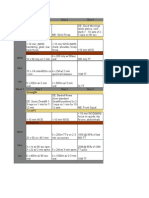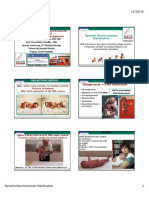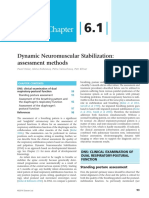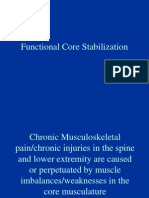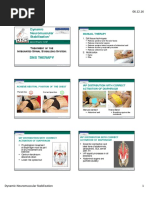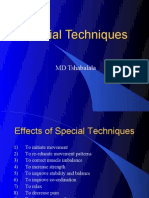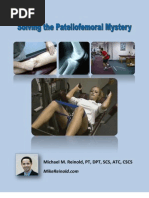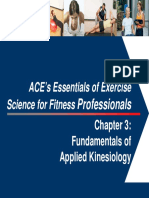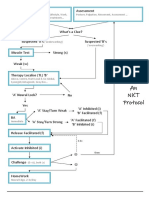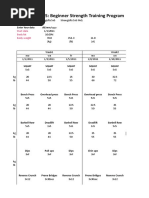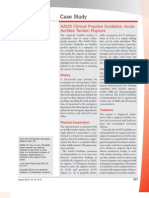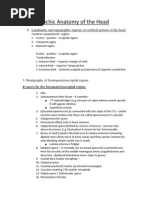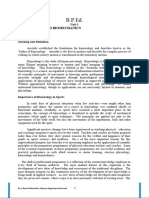DNS - Sport III Part1
DNS - Sport III Part1
Uploaded by
jole000Copyright:
Available Formats
DNS - Sport III Part1
DNS - Sport III Part1
Uploaded by
jole000Original Description:
Copyright
Available Formats
Share this document
Did you find this document useful?
Is this content inappropriate?
Copyright:
Available Formats
DNS - Sport III Part1
DNS - Sport III Part1
Uploaded by
jole000Copyright:
Available Formats
www.rehabps.
com
11.12.13
DNS Functional tools
Kolars Approach to Dynamic
Neuromuscular Stabilization in sport
and fitness
DNS Exercise course PART III/1
Rehabilitation Clinic
University Hospital Motol
Charles University
Prague, Czech Republic
Athletic performance
! Throwing, kicking,
lifting, running,
jumping!.
! Involves part of the
global patterns
! Picture of perfect
body segments
aligment
Functional joint
centration
Functional joint centration
= Neutral joint position
! Able to generate maximal muscle
power
! Improve sport performance
! Equal loading of the joints - decreases
load on ligaments and tendons, prevent
cartilage overuse and degeneration
! May prevent repetitive strain injury
Dynamic Neuromuscular Stabilization
! Posture assesment comparison with
ideal developmental posture
! Movement analysis in context with ideal
developmental pattern
! Corrective training of the stabilizing and
dynamic function of the muscles in the
kinematic chain
Development of
Functional Joint
Centration
Position of joints is
controlled by coordinated
co-contraction of
antagonists. Also linked
up with muscles providing
joint stabilization.
Well balanced activity of
antagonists ensures wellcentrated joints and this
depends only on a
normally developed CNS.
Physiological development
4,5 months: sagittal stabilization of
spine, chest and pelvis completed
Physiological
CNS maturation
!Ideal stabilization
!Ideal
biomechanical
condition
!Functional joint
centration
www.rehabps.com
!"#$%&'&(%)*'+
11.12.13
Postural Tasks
Loading, Exercise, Weightlifting..
!*,"&'&(%)*'+
Viscera are pressurized by diaphragm,
pelvic floor and abdominal wall
Intra-abdominal pressure increases
Posture = Initial position (axis)
diaphragm and pelvic floor Essential
Quality of stabilization pattern
Global motor
patterns
m. transversus abdominis
!!! YES !!!
!!! NO !!!
Ipsilateral
p.
Throwing, kicking, lifting,
running, jumping!.
Involves always part of those
global patterns
Sagittal stabilization
Kontalateral p.
2nd phase of development un subcortical
level: Between 5-12 months:
Stepping forward and supporting function of
the extremities
Ipsilateral pattern
Contralateral pattern
Dynamic Neuromuscular Stabilization
Ipsilateral pattern
Contralateral pattern
!"#$%&'()*$
! +,*-./(01/.$,/201'$3040.&,*$
51&%$*6,-'0$,&*-7&'$
! 8&'(1/./(01/.$51&%$,1&'0$
,&*-7&'$
9:01$#()$%&'()*$
! ;/<=$*(/1(*$(&$*>-(?)$
<0(>00'$-,*-$/'3$
?&'(1/./(01/.$,/201'$
! 8&%<-'0*$<&()$,/201'*$-'$
*,&'(/'0&6*$%&40%0'(*$
www.rehabps.com
11.12.13
Ipsilateral patterns in Motor
development
! Rolling from supine to prone
! Oblique sit
++++++++++++-+.&/,"$0+$,*1,$+,21/%/(+
@*($&<.-A60$/<3&%-'/.$%6*?.0$?)/-'!"#$%%&"'()"
#)%*+&"+,"'()"-+.)/01,"12".1'301,""4""'153.-&"'()"
&$##1.0,6"3.7"""
!
!
!
!
Ipsilateral patterns
Throwing
Ground Strokes
Golf swing
Kicking
3+.&/,"$0+,21/%/(+)&.4'5,56+
B'3$&<.-A60$/<3&%-'/.$%6*?.0$?)/-'!""
8$%%&"9.1'3')&:"'()"$##)."#3.'"12"'()";1-<""'153.-&"'()""
/1,'.3%3').3%"=>?>"
>'.3+6('),+,6"$#"1,"'()"&$##1.0,6")%;15"
"""
Cocking ! acceleration
Acceleration muscle activity
C(0,,-'D$5&1>/13$
*6,,&1($
C(0,,-'D$5&1>/13$
*6,,&1($
;/?E>/13$F$*,-'0$
1&(/7&'$
F)1&>-'D$/1%G$HIJ$9;KJ$
HL$
M&1>/13$F$1&(/7&'$
F)1&>-'D$/1%G$N4($MOJ$
9KKJ$+L$
Dynamic Neuromuscular Stabilization
8)/&"@">="()%#"'1"
.1'3')"
A(1.3B"
C3'@"7+-"A.3#@"
D(17;1+-&""/1,'.1%"
&#+,)".1'301,"
*6,,&1($
@*($W<.-A60$?)/-'$
1&(/(0$,0.4-*$
B'3$W<.-D60$?)/-'$
1&(/(0$()&1/V$
C(0,,-'D$
5&1>/13$
.-%<*$
RNCSLM$*(/<-.-T0$,0.4-*$
$HLJ$U.6(*$0V?0'(1-?$$
9KK$1&(/(0$,0.4-*$
F-<-/.-*$/'(01-&1$
P1&'/(&1*Q*6,-'/(&1*$
8&"/?74/7&'$
*6,,&1($
O&/3$-'?10/*0$$
www.rehabps.com
11.12.13
Support function upper extremity
! Facial side support function
! Scapula is centrated around
head of the humerus via distal
muscle pull (long head of biceps,
triceps, external rot.) and
adheres toward the thorax via
serratus ant and oblique muscle
chains
! ADD of the scapula has distal
pull and upright T spine allow
segmental rotation via mm
multifidis, rotatores
! Proper stabilization function and
centrated segmental aligment
allow greatest muscullar
efficiency on the fasical side
! Medial edge of the
scapulae should be
parallel with spine
! Angles adhering
towards rib cage
! Mid trapesius and
rhomboidei uprighting
T spine
! Via serratus anterior
connected with
abdominal wall
oblique muscle chains
Support function - lower extremity
Supporting leg
Tibialis ant. and triceps keep the ankle in 90- fix point
Hamstrings and rectus abd. - dorsal tilt of pelvis
! Weight bearing on the left
foot
! Knee extension via vasti and
gastrocnemii
! ADD rotates pelvis around
the hip
! Rectus femoris and
hamstrings in cocontraction
control ventrodorsal stability
of the pelvis
! External rot. via excentric
contraction controls
lateral stability in hip
!
distal muscle pull
External rotatores rotate the pelvis around the hip
Add- antigravity function
Stepping forward
Stepping forward
weightbearing
Contralateral patterns in development
!
!
!
!
Stabilization of the
shoulder blade
Crawling
Tripod
Standing up
Walking
5th MONTHS
WB on medial elbow, < 90 shld flexion
! WB on pubic symphysis and L-S area
- time where the pelvis reaches neutral
position and there is a coordination
between pelvic floor and diaphragm
muscles to produce the intra-abdominal
pressure for stability
Dynamic Neuromuscular Stabilization
www.rehabps.com
Contralateral pattern
11.12.13
Trunk stabilization via oblique
muscle chains
Stepping forward
Contralateral pattern in sport
! Running
! Skating
! Skiing
! Jumping from one leg long jump, high jump
! Cycling
Global motor patterns
! Critical for physiological development of our
structure
! Dynamic neuromuscular strategy that leads to
optimal joint position that allows for the most
effective mechanical advantage during full range
of movement
! Allows for maximal muscle pull and protection of
passive structures
! Well balanced activity of antagonists ensures
well-centrated joints and this depends only on a
normally developed CNS
Dynamic Neuromuscular Stabilization
Athletic Performance
Automatic utilization of all the principles described
!Automatic integration of postural locomotion function with
afferent information
!Oro-facial muscles also fulfill stabilization function
!Integration of eyesight eyes are leading, move (proceed) in
the direction of stepping forward = throwing hand
!Reciprocal position/movement of the extremities.
Muscle function????
Excentric contraction
Distal muscle pull
Stabilization function
Concentric contraction
Proximal muscle pull
Steping forward
www.rehabps.com
11.12.13
How to asses the quality of the
postural function
Janda: Minimum muscle activity is necessary for
primary stance: Evaluate muscle tone distribution
! Visual assesment of the posture
muscle tone distribution
! DNS tests postural function of
diaphragm and core
! Movement analysis compare with
quality of global pattern (ipsilateral,
contralateral..)
! Quality of cortical function ability of
relaxation and making isolated movements
Clinical Postural Impairments
$XW,0'$$
C?-**&1*Y$
8)0*($%&40*$
$/'(01-&1.=$
$P0.4-*$%&40*$$
/'(01-&1.=$
www.rehabps.com
DNS principles for athletic
population and training!
Dynamic Neuromuscular Stabilization
You might also like
- Split Quickstart GuideDocument1 pageSplit Quickstart Guidejole00050% (2)
- Bryan Mann - Developing Explosive Athletes PDFDocument43 pagesBryan Mann - Developing Explosive Athletes PDFjole000100% (17)
- (David Weinstock) NeuroKinetic Therapy An InnovatDocument151 pages(David Weinstock) NeuroKinetic Therapy An Innovatsitti fatimah azzahra. m100% (5)
- (David Weinstock) NeuroKinetic Therapy An InnovatDocument151 pages(David Weinstock) NeuroKinetic Therapy An Innovatvioly100% (2)
- Butler 1991 Mobilisation of The Nervous SystemDocument265 pagesButler 1991 Mobilisation of The Nervous Systemiruizmolina67% (15)
- Fascia in Sport and Movement Nodrm PDFDocument474 pagesFascia in Sport and Movement Nodrm PDFCristian Mihăescu96% (24)
- The Shoulder: Theory & Practice: Jeremy LewisDocument3 pagesThe Shoulder: Theory & Practice: Jeremy Lewisparakram50% (2)
- FMS 2 Corrective Strategies (Online Course)Document38 pagesFMS 2 Corrective Strategies (Online Course)Omar Cepeda100% (24)
- Dns PDFDocument22 pagesDns PDFOtrovanje100% (1)
- Progression-Regression Chart PDFDocument3 pagesProgression-Regression Chart PDFjole000100% (3)
- DNS Exercise IDocument34 pagesDNS Exercise IOtrovanje100% (4)
- Z-Health Free Vision Gym ExercisesDocument7 pagesZ-Health Free Vision Gym Exercisesgleko150% (4)
- 12 Week CFE Advanced Training Plan Master1Document6 pages12 Week CFE Advanced Training Plan Master1Brian Michael CarrollNo ratings yet
- Dynamic Neuromuscular Stabilization Dynamic Neuromuscular StabilizationDocument25 pagesDynamic Neuromuscular Stabilization Dynamic Neuromuscular StabilizationAnthony Harder100% (3)
- Dynamic Neuromuscular StabilizationDocument20 pagesDynamic Neuromuscular StabilizationAnanda Kartika P.100% (3)
- The Asymmetric Pelvis: Liz Gaggini, M.ADocument7 pagesThe Asymmetric Pelvis: Liz Gaggini, M.Aleo100% (3)
- Nds Lower Quarter Course Manual PDFDocument105 pagesNds Lower Quarter Course Manual PDFMskola Karlovac100% (1)
- SFMA Score Sheet PDFDocument7 pagesSFMA Score Sheet PDFdgclarkeNo ratings yet
- Applied Functional Science Afs PPDocument9 pagesApplied Functional Science Afs PPapi-414772091No ratings yet
- Measuring Walking: A Handbook of Clinical Gait AnalysisFrom EverandMeasuring Walking: A Handbook of Clinical Gait AnalysisRating: 5 out of 5 stars5/5 (2)
- NATA 2015 Presentation - Dan Houglum PDFDocument77 pagesNATA 2015 Presentation - Dan Houglum PDFRaunaq Salat100% (1)
- Sfma Flow ChartDocument17 pagesSfma Flow ChartStuart Meints80% (5)
- Cook and Plisky - Balance, Posture and MovementDocument57 pagesCook and Plisky - Balance, Posture and MovementFlávio Garrett100% (4)
- SFMA Shoulder Corrective Exercises by SportsRehabExpert - Com (C) 2010Document9 pagesSFMA Shoulder Corrective Exercises by SportsRehabExpert - Com (C) 2010Zachary Lee100% (4)
- SFMA Shoulder Corrective Exercises PDFDocument9 pagesSFMA Shoulder Corrective Exercises PDFamirreza jmNo ratings yet
- Anatomy Trains Map 2Document13 pagesAnatomy Trains Map 2Ivan Medić100% (4)
- Becoming the Ultimate Physio: A practical guide to private practice successFrom EverandBecoming the Ultimate Physio: A practical guide to private practice successNo ratings yet
- Female Specialisation Program Outline 1Document15 pagesFemale Specialisation Program Outline 1jole00067% (3)
- Male Specialisation Program OutlineDocument15 pagesMale Specialisation Program Outlinejole000100% (1)
- Seven Fat Loss Finishers PDFDocument8 pagesSeven Fat Loss Finishers PDFjole000No ratings yet
- Seven Fat Loss Finishers PDFDocument8 pagesSeven Fat Loss Finishers PDFjole000No ratings yet
- Upper Extremity FracturesDocument50 pagesUpper Extremity FracturesClexNo ratings yet
- MCQ Biomechanics of Hip Joint 2Document15 pagesMCQ Biomechanics of Hip Joint 2Abdul Musawer0% (1)
- Pelvic C ClampDocument11 pagesPelvic C ClampFachry Al RafiqiNo ratings yet
- DNS Chaitow Book 2Document6 pagesDNS Chaitow Book 2Milos DjuricNo ratings yet
- DNS Intro 2016Document14 pagesDNS Intro 2016Asnita Zulqaida100% (1)
- Kolar 2014Document6 pagesKolar 2014Arnold Barra100% (1)
- What Is Dynamic Neuromuscular Stabilization (DNS) ?: How Is The Core Stabilized?Document5 pagesWhat Is Dynamic Neuromuscular Stabilization (DNS) ?: How Is The Core Stabilized?HONGJYNo ratings yet
- Functional Core StabilizationDocument71 pagesFunctional Core StabilizationFábio De Ávila Peres100% (3)
- FMS SFMA Triage PDFDocument1 pageFMS SFMA Triage PDFdgclarke100% (1)
- Principles of Postural Restoration For The Sports PB SummitDocument11 pagesPrinciples of Postural Restoration For The Sports PB Summitmaximo100% (1)
- 5 DNSA Treatment PDFDocument9 pages5 DNSA Treatment PDFklinik bapelkes ksNo ratings yet
- MSR Corrective ExercisesDocument20 pagesMSR Corrective ExercisesTomBrambo100% (3)
- 4 DNSA Assessment PDFDocument10 pages4 DNSA Assessment PDFklinik bapelkes ks100% (1)
- Core Stability Exercise PrinciplesDocument6 pagesCore Stability Exercise Principlesphysioali0% (2)
- Preparing Your Patients For The Game of Life and SportDocument24 pagesPreparing Your Patients For The Game of Life and SportDenis FosterNo ratings yet
- DNS PDFDocument12 pagesDNS PDFMaksim BogdanovNo ratings yet
- The Proximal To Distal PrincipleDocument9 pagesThe Proximal To Distal PrinciplePușcașu CătălinaNo ratings yet
- The 4x4 MatrixDocument23 pagesThe 4x4 Matrixpfi_jen100% (1)
- Anatomy Trains and NKTDocument11 pagesAnatomy Trains and NKTAlisaClark100% (1)
- 骨盆底 讲义Document172 pages骨盆底 讲义zhang yang100% (1)
- FryetteDocument2 pagesFryetteSaba KhanNo ratings yet
- PNF Special TechniquesDocument26 pagesPNF Special TechniquesMuziwakhe Tshabalala100% (5)
- Kozar ScienceOfMotorControlLectureDocument114 pagesKozar ScienceOfMotorControlLectureMari Pao100% (1)
- PNF BasicsDocument38 pagesPNF Basicsbpt2100% (3)
- Functional Movement Assessment Score SheetDocument1 pageFunctional Movement Assessment Score Sheetapi-513768116No ratings yet
- Anatomy Trains 6 Color NotesDocument24 pagesAnatomy Trains 6 Color Noteskabshiel93% (15)
- Visceral Manipulation in Structural Work: Liz Gaggini, M.ADocument6 pagesVisceral Manipulation in Structural Work: Liz Gaggini, M.AleoNo ratings yet
- Mike Reinold - Solving The PF MysteryDocument36 pagesMike Reinold - Solving The PF MysteryCarrie SagoNo ratings yet
- Chapter 3 - Fundamentals of Applied KinesiologyDocument60 pagesChapter 3 - Fundamentals of Applied KinesiologySam100% (1)
- NKT FlowChart - PDF Version 1 PDFDocument2 pagesNKT FlowChart - PDF Version 1 PDFJay SarkNo ratings yet
- 3 - DNSA - Ideal - Stabilization PDFDocument6 pages3 - DNSA - Ideal - Stabilization PDFklinik bapelkes ksNo ratings yet
- Length Tension Testing Book 1, Lower Quadrant: A Workbook of Manual Therapy TechniquesFrom EverandLength Tension Testing Book 1, Lower Quadrant: A Workbook of Manual Therapy TechniquesRating: 3.5 out of 5 stars3.5/5 (3)
- Releasing Cranial/Dural Strains, Eliminating the Mystique: A Simple, Concise, New TechniqueFrom EverandReleasing Cranial/Dural Strains, Eliminating the Mystique: A Simple, Concise, New TechniqueRating: 5 out of 5 stars5/5 (1)
- Length Tension Testing Book 2, Upper Quadrant: A Workbook of Manual Therapy TechniquesFrom EverandLength Tension Testing Book 2, Upper Quadrant: A Workbook of Manual Therapy TechniquesRating: 1 out of 5 stars1/5 (1)
- Purpose Driven Movement: A System for Functional TrainingFrom EverandPurpose Driven Movement: A System for Functional TrainingNo ratings yet
- Improving Ankle and Knee Joint Stability: Proprioceptive Balancefit Discs DrillsFrom EverandImproving Ankle and Knee Joint Stability: Proprioceptive Balancefit Discs DrillsNo ratings yet
- Metabolic Conditioning Methods Chart 1 PDFDocument1 pageMetabolic Conditioning Methods Chart 1 PDFjole000No ratings yet
- Getting Leaner: Introduction To HypertrophyDocument1 pageGetting Leaner: Introduction To Hypertrophyjole000No ratings yet
- Program Design 101 PDFDocument13 pagesProgram Design 101 PDFjole000100% (1)
- The IFAST Assessment: Anterior Pelvic TiltDocument6 pagesThe IFAST Assessment: Anterior Pelvic Tiltjole000No ratings yet
- Beyond Bodybuilding by Alberto Nunez (PDF of All Lessons)Document32 pagesBeyond Bodybuilding by Alberto Nunez (PDF of All Lessons)karan jain67% (3)
- Program Design 101 PDFDocument13 pagesProgram Design 101 PDFjole000100% (1)
- Progression-Regression Chart PDFDocument3 pagesProgression-Regression Chart PDFjole000No ratings yet
- Stronglifts 5X5: Beginner Strength Training Program: Start Date Body Fat Body-WeightDocument27 pagesStronglifts 5X5: Beginner Strength Training Program: Start Date Body Fat Body-Weightjole000No ratings yet
- Intro and R7 Training PDFDocument11 pagesIntro and R7 Training PDFjole000100% (1)
- Beyond Bodybuilding by Alberto Nunez (PDF of All Lessons)Document32 pagesBeyond Bodybuilding by Alberto Nunez (PDF of All Lessons)karan jain67% (3)
- The IFAST Assessment: Anterior Pelvic TiltDocument6 pagesThe IFAST Assessment: Anterior Pelvic Tiltjole000No ratings yet
- Some Important Points: Raya Pro InstallationDocument2 pagesSome Important Points: Raya Pro Installationjole000No ratings yet
- Evening Hunger Template FAQDocument11 pagesEvening Hunger Template FAQjole000No ratings yet
- F 5 M ModerateDocument72 pagesF 5 M Moderatejole000No ratings yet
- Juggernaut Method Calculator: Training Maxes (90% 1RM) 1RM InputDocument35 pagesJuggernaut Method Calculator: Training Maxes (90% 1RM) 1RM Inputjole000No ratings yet
- Exercise and Physical Activity For Children With Prader WilliDocument36 pagesExercise and Physical Activity For Children With Prader Willijole000No ratings yet
- Monday - Dynamic BenchDocument8 pagesMonday - Dynamic Benchjole000No ratings yet
- PrintableWorkoutSheets PDFDocument23 pagesPrintableWorkoutSheets PDFjole000No ratings yet
- Juggernaut Method JoleDocument3 pagesJuggernaut Method Jolejole000No ratings yet
- A Sport Medicine Manual PDFDocument371 pagesA Sport Medicine Manual PDFpicilivi100% (2)
- Bodyweight Strength Training ManualDocument43 pagesBodyweight Strength Training ManualRonalth PerezNo ratings yet
- FroDocument5 pagesFrochinmayghaisasNo ratings yet
- Core Stability ExercisesDocument5 pagesCore Stability ExercisesAfizie100% (1)
- Rehabilitation Protocol For Meniscus RepairDocument16 pagesRehabilitation Protocol For Meniscus RepairAnonymous ecI8GUbaNo ratings yet
- Osteoporosis - PathophysiologyDocument2 pagesOsteoporosis - PathophysiologyMary April MendezNo ratings yet
- Achilles Tendon RuptureDocument3 pagesAchilles Tendon RuptureorthohealthNo ratings yet
- Exam Corner: October 2014 - QuestionsDocument2 pagesExam Corner: October 2014 - QuestionsNishil ModiNo ratings yet
- Aaos 2002Document120 pagesAaos 2002Yusufa ArdyNo ratings yet
- Surgical Approaches For Tibial Plateau Fractures: Utku Kandemir, MD Jeffrey Maclean, MS, MDDocument9 pagesSurgical Approaches For Tibial Plateau Fractures: Utku Kandemir, MD Jeffrey Maclean, MS, MDGustavoBecerraNo ratings yet
- A Neuromechanical Investigation of The DipDocument139 pagesA Neuromechanical Investigation of The Dipexco1327No ratings yet
- AO Surgery Reference Lenke ClassificationDocument1 pageAO Surgery Reference Lenke ClassificationFederico Nelson FreisNo ratings yet
- Disability Certificate GuidelinesDocument55 pagesDisability Certificate GuidelinesShibani BudhrajaNo ratings yet
- Principles of Amputation Surgery, Prosthetics, And.7Document12 pagesPrinciples of Amputation Surgery, Prosthetics, And.7cooperorthopaedicsNo ratings yet
- HoopsU Vertical Jump Training Workout PDFDocument8 pagesHoopsU Vertical Jump Training Workout PDFlebronNo ratings yet
- Mastering Ring Muscle Ups For BeginnersDocument30 pagesMastering Ring Muscle Ups For BeginnersmohammadarhabfirozNo ratings yet
- Orthopedics of The Upper and Lower Limb, 2013Document181 pagesOrthopedics of The Upper and Lower Limb, 2013Ari Samad100% (2)
- Praktikum Struktur HewanDocument28 pagesPraktikum Struktur HewanSt. Asyah Alya Faradiba.pNo ratings yet
- 2 Anatomy of TMJDocument117 pages2 Anatomy of TMJSugandhi Pidaparthi100% (1)
- Degenerative Joint Diseases - Admisson ExamDocument23 pagesDegenerative Joint Diseases - Admisson ExamNona NadimNo ratings yet
- Dissecting A Chicken Wing: Lab SafetyDocument21 pagesDissecting A Chicken Wing: Lab SafetyWynona Louiz TangcoNo ratings yet
- Movement Competency Screen (MCS)Document12 pagesMovement Competency Screen (MCS)Eliza ValenzuelaNo ratings yet
- Topograpchic Anatomy of The HeadDocument3 pagesTopograpchic Anatomy of The HeadtastykNo ratings yet
- BP201 Kinesiology and BiomechanicsDocument26 pagesBP201 Kinesiology and Biomechanicsbeherasrimanta43No ratings yet
- Series Coding Certification Tips - CompressDocument15 pagesSeries Coding Certification Tips - CompressAbhishek jogdandNo ratings yet
- HUMAN ENDOSKELETON(FTB+STB)pdfDocument1 pageHUMAN ENDOSKELETON(FTB+STB)pdfWaqar AhmadNo ratings yet
- Bone Lab - ASU - Ask A BiologistDocument4 pagesBone Lab - ASU - Ask A BiologistRisa SahiraNo ratings yet













